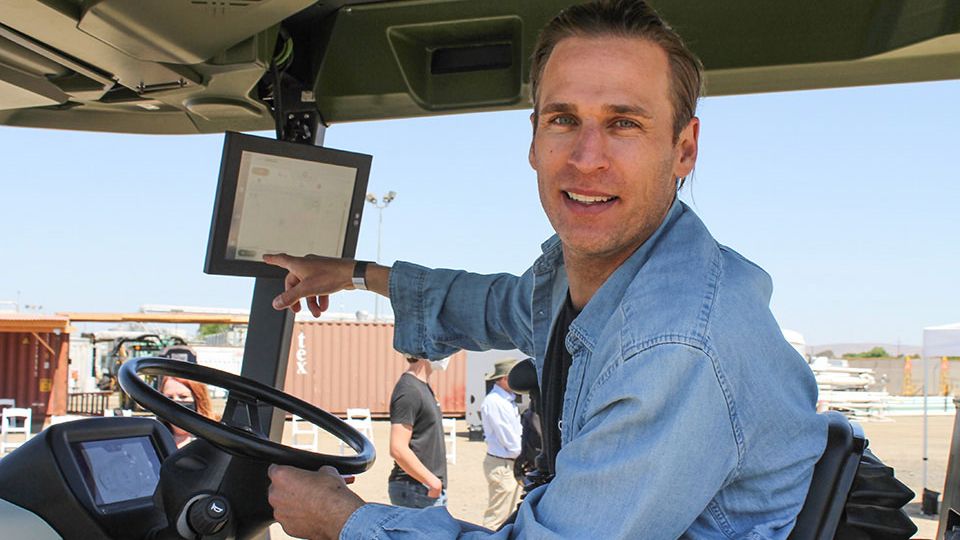First Fully Electric ‘Smart’ Tractor Makes Debut

Carlo Mondavi, Chief Farming Officer of Monarch Tractor, points out some of the features of the company’s flagship product, the first electric, ‘smart’ tractor. Mondavi, the grandson of one of the giants of California wine, Robert Mondavi, says the tractor needs no driver. (Photo: David Eddy)
Monarch Tractor, the world’s first fully electric, driver-optional, smart tractor manufacturer, announced the debut of its flagship tractor recently at Wente Vineyards of Livermore, CA, the oldest continuously operated family winery in the U.S. The announcement was made, appropriately enough, on Earth Day.
“The average tractor puts out emissions equal to 17 cars,” said Carlo Mondavi, one of the company’s four cofounders, who serves as Chief Farming Officer. “The days of fossil fuel farming are now behind us.”
Carlo Mondavi is the grandson of Robert Mondavi, a giant name in the wine business. In 2004, the Robert Mondavi Corp. was acquired by beverage giant Constellation Brands for $1.03-billion in cash. Carlo Mondavi came up with the company’s name. He is cofounder of the Monarch Challenge, an effort born in Napa and Sonoma counties to farm without herbicides.
Monarch Tractor and Wente have been partners throughout the tractor’s beta phase. The two companies found synergy with Monarch’s traditional farming features, cutting-edge technology, and sustainable capabilities, merging the Livermore wine region with Silicon Valley tech.
“We’ve seen firsthand the benefits of the Monarch Tractor in our vineyards,” said Niki Wente, Wente Vineyards. “Monarch Tractor represents the future of tractors and to be the first customer deployment is especially exciting as we kick off this new era of sustainable farming.”
Cap-and-Trade Funding
The development of the tractor was enabled through a grant from the California Air Resources Board (CARB) FARMER Program. FARMER is part of California Climate Investments, a statewide program that puts billions of cap-and-trade dollars to work reducing greenhouse gas emissions, strengthening the economy, and improving public health and the environment, particularly in underserved communities.
Additionally, CARB contributed to the FARMER program by adding Advanced Technology Demonstration Projects, an initiative leading to a grant offered to Monarch Tractor by CARB through the Bay Area Air Quality Management District.
“Monarch has demonstrated great leadership in the manufacturing industry to help reduce air pollution and protect the climate with their innovative zero-emission farming equipment,” said Jack Broadbent, executive officer of the Air District. “The Air District was pleased to award Monarch this grant funding to further this work.”
The Monarch Tractor combines electrification, automation, machine learning, and data analysis to set what Mondavi called a new standard in tractor technology and capabilities. There are a total of 10 cameras on the tractor, he said, positioned at different levels to look at different aspects of the vineyard. For example, several are positioned to look into the vine canopy, enabling the grower to do cluster counts, help evaluate vine health, etc.
Another of the company’s co-founders, Chief Technology Officer Dr. Zachary Omohundro, calls it “no-compromise technology,” because growers don’t need to give up anything found on conventional tractors. “It can do everything a regular tractor can do, plus it can operate automatically, plus data collection, plus it’s electric,” he said.
Omohundro, who has a PhD in Robotics from Carnegie-Mellon University, said that not only is tractor “smart,” it improves the usefulness of other equipment used on the farm. For example, sensors on board can tell the grower how much torque is going to the mower. “A Bush Hog is not ‘smart,’” he said, “but it is with a Monarch.”
Another co-founder, Chief Executive Officer Praveen Penmetsa, is a mechanical engineer who has developed products in various fields before focusing on agricultural technology in 2016, said the key to the tractor’s development was in simply taking a fresh look at an old technology.
“The big part of this is it’s high time the tractor was reimagined from the ground up,” he said. “A lot of technology is available to make the job easier for everyone.”
Penmetsa conceded, however, that part of the reason all the technology is available is because of their Northern California location.
“This area – the Silicon Valley, the Napa Valley, and the San Joaquin Valley – are ground zero for the global transformation you will see,” he says. “Look at the public perception of electric vehicles, they were basically golf carts until Tesla arrived.”
The Tesla Model
Speaking of Tesla, the last of the company’s co-founders, Mark Schwager, who serves as President, was with the electric car manufacturer for many years. He served as chief of the Tesla “Gigafactory,” leading the giant project built near Reno, NV from concept phase to construction.
“We saw this as an untapped space, the electrification of farming,” he says. “If the technology is appropriate for cars, why was nobody solving this problem?”
It wasn’t easy. For one thing, negotiating a smooth roadway is nothing compared to the tough environment of the farm. For another, they wanted a tractor that could be used in the narrow rows of the typical older vineyard, which are often too small to for the average car, with a width of about 6 feet. That was the greatest challenge, building a tractor just half of that width, but not skimping on the battery nor the drive-train system.
The battery in the tractor is on par with the largest Tesla vehicle battery, he said, and can last for 6 to 8 hours of continuous use on one charge. Electric tractors also have a major advantage in that the 70 horsepower the unit puts out delivers twice as much torque as a conventional compact tractor with the same horsepower.
Schwager believes Monarch can follow the Tesla example. Acceptance of the electric cars was initially slow, but once it began, it was all but unstoppable. “Once you’ve got 2 to 3% of the market, you’ve got it,” he says. “Today, 10% of the vehicles sold in California are electric.”
They are sold out for this year, Penmetsa said, but those interested in the unit for 2022 can go to the company website for information about ordering one of the tractors, which have a base price of $50,000.









